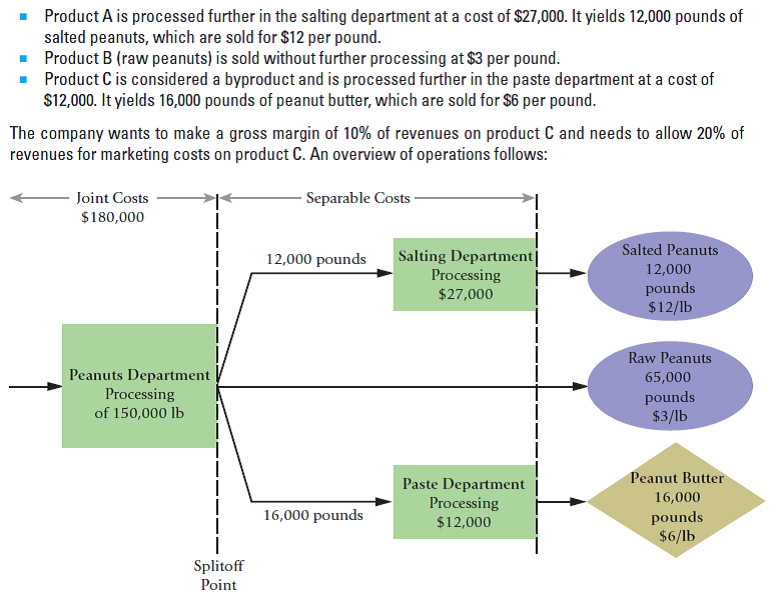Product A is processed further in the salting department at a cost of $27,000. It yields 12,000 pounds of salted peanuts, which are sold for $12 per pound. Product B (raw peanuts) is sold without further processing at $3 per pound. Product C is considered a byproduct and is processed further in the paste department at a cost of $12,000. It yields 16,000 pounds of peanut butter, which are sold for $6 per pound. The company wants to make a gross margin of 10% of revenues on product C and needs to allow 20% of revenues for marketing costs on product C. An overview of operations follows: - Separable Costs - Joint Costs $180,000 Salting Department Processing $27,000 Salted Peanuts 12,000 pounds 12,000 pounds $12/lb Raw Peanuts Peanuts Department Processing of 150,000 lb 65,000 pounds $3/lb Peanut Butter Paste Department Processing 16,000 16,000 pounds pounds $6/lb $12,000 Splitoff Point 1. Compute unit costs per pound for products A, B, and C, treating Cas a byproduct. Use the NRV method for allocating joint costs. Deduct the NRV of the byproduct produced from the joint cost of products A and B. 2. Compute unit costs per pound for products A, B, and C, treating all three as joint products and allocat- ing joint costs by the NRV method. Required
Process Costing
Process costing is a sort of operation costing which is employed to determine the value of a product at each process or stage of producing process, applicable where goods produced from a series of continuous operations or procedure.
Job Costing
Job costing is adhesive costs of each and every job involved in the production processes. It is an accounting measure. It is a method which determines the cost of specific jobs, which are performed according to the consumer’s specifications. Job costing is possible only in businesses where the production is done as per the customer’s requirement. For example, some customers order to manufacture furniture as per their needs.
ABC Costing
Cost Accounting is a form of managerial accounting that helps the company in assessing the total variable cost so as to compute the cost of production. Cost accounting is generally used by the management so as to ensure better decision-making. In comparison to financial accounting, cost accounting has to follow a set standard ad can be used flexibly by the management as per their needs. The types of Cost Accounting include – Lean Accounting, Standard Costing, Marginal Costing and Activity Based Costing.
Joint costs and byproducts. (W.Crum adapted) Royston,Inc., is a large food processing company. It processes 150,000 pounds of peanuts department at a cost of $180,000 to yield 12,000 pounds of product A, 65,000 pounds of product B, and 16,000 pounds of product C.


Trending now
This is a popular solution!
Step by step
Solved in 5 steps with 4 images









